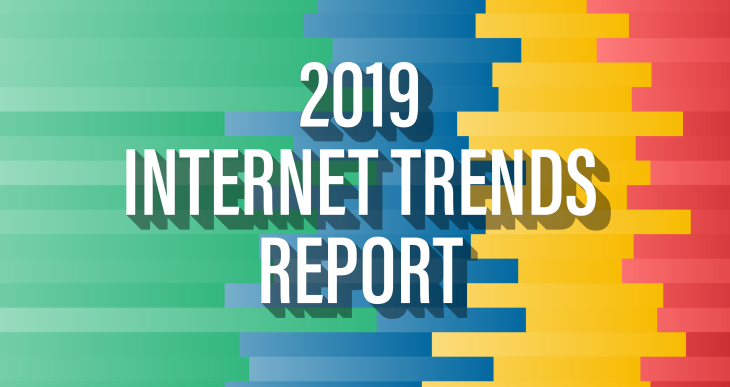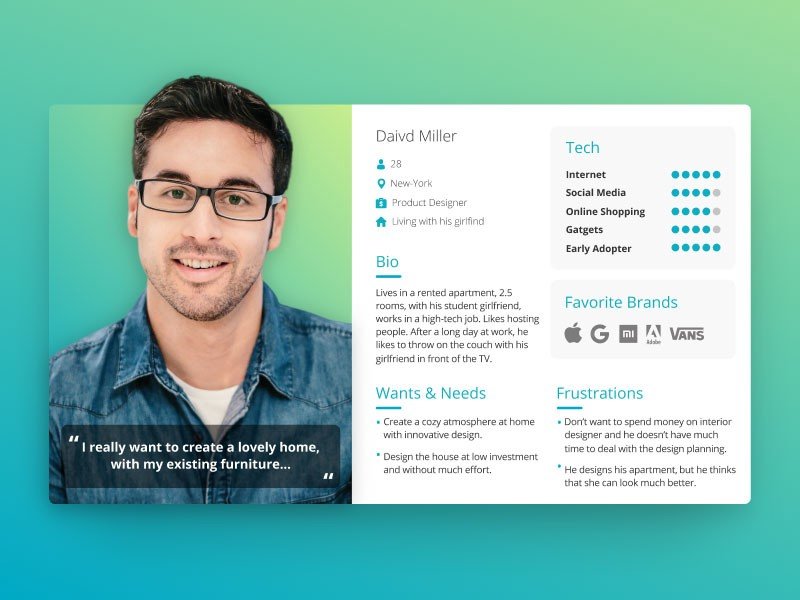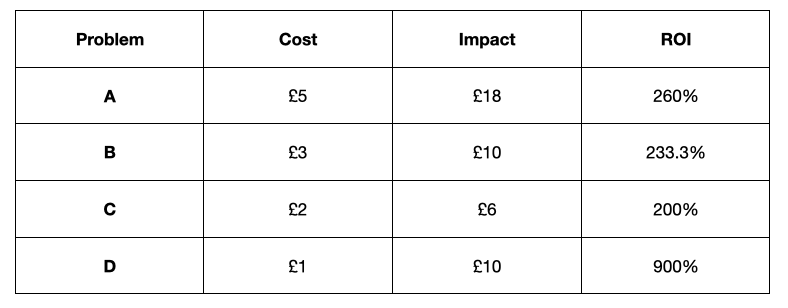2. Problem identification
How to identify problems
When you’re building products one of the most important things is to make sure that you’re solving the right problems…

One of the hardest things to do is to decide what not to solve.
- Identify Opportunities
- Understanding the Market
- The Target User
- Total Addressable Market
- Creating and Evaluating Hypothesis
- Building a Business Case
Identifying Opportunities
Finding the right problems to solve is critical for the success of your product and the business. If you aren’t focusing on the right problems, your product will fail. This is something both big and small companies struggle with. You’ll need to work through a lot of constraints and trade-ffs to get this right.
How to work out which problem to solve:
There are lots of different ways you can get signal .
- Research – most insightful
Market research is helpful in understanding the current space. What products or related products already exist? What’s the competition like? What are the trends?
User research is super-critical here also and there are lots of different forms of user research that can take place, such as ethnographies, interviews, and focus groups, etc…

go out and talk to users.
- Product Data
In a case where you might already have an existing product and you’r looking for a follow-on product, you already have some additional data that you can look at. Look at how your current product is being used or not being used. This will give you an understanding of problems that users might be running into with your current product and potentially ideas for new features.
- Support Data
This will give you a sense of the type of issue your users are running into. Fixing these issues will reduce bad experiences for customers and it will also reduce the amount of money the company spends on providing support.
- Efficiency Gains
These are things that will allow you to scale and provide more value over time – if there is a manual process your engineering team has to do, if you automate that process, it frees up more bandwidth for the team to solve new problems.
Constraints & Tradeoffs
Time is limited. There are a limited number of people on your team. It’s not possible to solve every problem. Not all problems have the same impact. Solving some problems will have tremendous impact whereas other problems might have almost negligible impact. Given limited time and differing levels of impact, not every problem is worth solving.
Business Goals
It’s important to keep business goals in mind. If products aren’t helping to meet business goals, they ultimately won’t survive long term. This could mean your product gets killed or worse that your company goes out of business. Business goals will likely come up when you build a business case:
- Increase Revenue
- Increase New Users
- Increase Engagement
- Decrease Costs
- Decrease Churn
- Other business KPI’s
Viable product Opportunities

As you start understanding business goals and evaluating problems, look for the overlap between these two. This is where you’ll find the viable product opportunities.
You can change everything in your startup except the market. So spend a lot of time up front to make sure you’ve thought through your market.
Sam Altman – Y Combinator
You can have the smartest most talented people on your team and you could be building amazing pieces of technology, but if your product doesn’t solve a problem that resonates with the market, none of that will matter.
As you start understanding business goals and evaluating problems,
- Why are we solving this problem
- What is the impact?
- Why with this specific solution over another? – make sure you can communicate this to your team
2. Understanding the Market
Product/Market Fit
Understanding the market is critical to building successful products. Some markets are better than others and some products do a better job than others. The key is to find product/market fit.

Product/market fit means being in a good market with a product that can satisfy that market.
Marc Andreesen
What makes a good market?
- Size
The more people, the more need, the more adoption and the easier it will be to monetise the product.
- Growth
Is the market growing? Think about smartphone penetration in the last 20 years.
- Acquisition
How easy is it to get new customers? Think about expanding your reach and your ability to explain your product to new users. This can include getting people to switch from competing products. Think about the friction when switching say from and Android to an iOS Phone, or from changing your e-mail provider from one to another.
it can be difficult to identify product/market fit
No Product/Market Fit
- Users aren’t getting value from the product
- No word of mouth – no recommendations
- No press buzz – no excitement
- Slow growth – make it difficult to sell
Product/Market Fit
- Users get a lot of value
- Product practically sells itself
- Press is reaching out to talk to you about your product
- Product is in high demand
Ways to get more Market Insight
It’s important to familiarise yourself as much as possible with what’s going on around your product space.
- Online research – what’s happening in the market
- Headlines and Relevant News
- Similar products – see how they have approached the problem what’s working well and where they are struggling
- Trends – can provide very important insights i.e. Mary Meeker’s Annual Internet Trends Reports & Google Trends

Industry Trends
Imagine that the team is interested in building a product to help people better track their fitness and improve their health over time. Spend a little bit of time doing some research to better understand current trends in the fitness tracking market.
Here are some questions to get you started:
- What benefits does improving fitness provide?
- What products are already in the market?
- How much do people spend on health/fitness?
- What are the different ways to deliver fitness tracking?
- What are the pros and cons?
example answers
Benefits
- Controls weight
- Combats health conditions & diseases
- Improves mood
- Boosts energy
- Sleep better
Existing Products
- Smartwatches
- Apps – General & Focused
- Smart Wrist Bands
Spending – My Protein (US)
- £152 / mo
- £1,857 / yr
Broken down into monthly spend:
- Supplements £51
- Clothing £32
- Gym £37
- Meal Plans £19
- Trainers £17
Then look at your ideas and do a pros and cons based on – investment (money and time), ease of use for user (best experience for the user with the least amount of effort on their part), market (how big is the market and how easy is it to enter it?) .. ideal scenario is: investment is low, ease of use is effortless, market is large.
3. Target User
Identifying a target user is important
Target users make it very clear who you’re building the product for. Often a problem will best be solved in different ways for different types of users. Identifying a target user creates focus, and lets you zoom in on solving the needs of that specific target user.

You must keep the target user in mind, when you’re building a product, because it will help you to answer a lot of questions about what your product is, and what it should do.
Target User
Users with shared characteristics who are likely interested in your product.
Data
- Market Research
- Interviews, Surveys, Focus Groups
- Customer Data
- Etc…
Once you have that data you will need to look at characteristics for trends in the data.
Characteristics
- Demographics – age and location
- Motivations – what gets them excited?
- Goals – what are they trying to accomplish?
- Frustrations – where are they running into current problems and challenges?
Once you’ve identified trends across you users you can create user personas to represent them.
A user persona is a fictional person that you create who might use your product. As you’re developing the product, you’ll refer back to your personas, in order to stress test and challenge sone of your ideas – does this decision solve David’s frustration, and would David be able to afford this product?
David Designer

- Real quotes from users that you’ve talked to during user research
- Description to paint a story about who they are and focused on things relevant to your product
- Frustrations or challenges that the user is facing
- Goals that your user has that your product helps them achieve
- Motivations related to your product – seeing progress over time, being able to share…
4. Total Addressable Market
TAM or Total Addressable Market
TAM, or total addressable market, is a measure of the revenue opportunity for a product or service. TAM is not a measure of your revenue or future revenue, but it allows you to understand the size of the market if you had 100% of the market. A larger TAM indicates a larger opportunity with more demand for a particular product.

TAM = ARPU x potential users in market
Top down TAM
The top down method uses industry research to estimate the size of an addressable market, this approach starts from a high macro-level view of the economy. You start with a total number of people in the world and you narrow down that number based on factors like demographics.
Top down TAM for bottled water in the US
7.8 billion people on Earth
330 million people in the US
2 litres of water per day
$1 per liter
(330 million people) x (2 litres per day) x ($1 per litre) x (365 days per year) = $241B
Bottoms up TAM
This involves using known data points that you have, this could come from early customers and sales, although you can use theoretical customers and sales, and then extrapolating them to represent a larger market opportunity. Imagine if you’re already selling bottle water in the state of CA:
Bottoms up TAM for bottled water in the US
10 million litres per day
$1 per liter
(10 million litres per day) x ($1 per litre) x (365 days per year) = $3.65B in CA
With bottoms up we look at our existing sales and scale them.
40 million people in CA buy 10 million litres (1 litre per day for every 4 people – 25%)
25%of population buys one litre per day
330 million people in the US
$1 per litre
(330 million people) x (25% of people ) x ($1 per litre) x (365 days per year) = TAM in the US $30.1B
This is a big difference Top down approach $241B, Bottom up $30.1B – due to the assumptions made.
Value Theory
Best used for brand new project categories where you don’t really have much information to base any of your estimates on. There are two main questions you need to answer.
- How much are people willing to pay for the product?
- How many will purchase the product?
TAM = price x people who woful purchase
To get to these numbers you will have to do a lot of research and talk to users to see what they would be willing to pay and to figure out an estimate for how many potential customers you will have.
5. ROI
Return on Investment
Understanding the ROI or Return on Investment of solving specific problems is critical. ROI for specific problems help you understand where to focus your team’s time in order to have the biggest impact.
What is ROI?
( amount gained – amount spent ) / amount spent
ROI is a way to measure the efficiency of an investment, like deciding to build a new product or feature. Amount gained can be sales but it can also be cost savings too. The impact needs to be something that can be measured in pounds (£).
These are just estimates and can get complicated when you start adding in lots of factors (seek help from the finance team or data science team to build this out in more detail).
The higher the ROI the better the business outcome. This is because high ROI means that you’re able to create more impact with less effort.
ROI software products
( impact – cost of development time ) / cost of development time
We estimate the cost of development time based on how many people are involved and how long it takes to complete the project. For instance if we had £5 to spend on developing products…

You could do problem B and D generating £20 with a cost of £4 and an ROI of 1133%! There’s one other thing to consider when calculating ROI, the payback period.
What is the payback period?
The amount of time that it takes to regain the initial cost of building the product.
cost / (impact / time to realise impact) = payback period

Calculating ROI and payback periods are two important tools to help you understand if it makes sense to solve a problem. Projects with positive ROIs will cover the core investment required to build the product. Projects with negative ROIs will not and won’t make sense to pursue. Calculating the payback period allows you to understand how long it will take before the product recoups the upfront investment that was required to build it.
6. Creating a Hypothesis?
Creating Hypothesis
Before you build a product, you want it to be successful. To make sure that your assumptions about your product are correct, for instance, that you’re solving a real problem for real people. You create hypothesis based on what you know so far and then test them to see if they’re still accurate and hold true in the real world.
- Customer Needs – Have you identified a customer need?
What are the specific goals of your customers that they are trying to reach and where is there an opportunity for you to be able to help them reach those goals and meet their needs.
Is this a real problem?
Is there an urgency in finding a solution to this problem?
Think of a painkiller vs a vitamin

Painkiller is must have and vitamin is nice to have. Is this problem a painkiller or are you just building a vitamin? If there’s no need or urgency, it’s likely that the product will fail.
- Your solution – Does your solution meet that need?
This will depend based on exactly what your product does or doesn’t do. Is our product the same or different and how is it different? What does it do that other products don’t?
When creating hypotheses related to your solution, the question your trying to answer is does your solution really solve the problem?
- What alternatives does the customer have? – if they don’t go with your solution
- Differentiation – Is your solution differentiated?
- How does your solution compare to other solutions out there?
- Is your solution way better? – how does it compare to everything else out there
- Value – Does your product create enough value for users?
Does your solution create enough value for users? Does your solution create enough value for users that they are willing to pay for it? If so how much? What would increase a users willingness to pay, and how much do they pay for alternative solutions?
Testing Hypothesis
You can test and evaluate your hypothesis in several different ways.
- User interviews – go an talk to your users, walk them through your thinking and get their thoughts and feedback – this works best with a prototype you can show to users and ask them to evaluate. Would the use it and consider buying, why or why not?
Are you solving a problem for users and how well are they perceiving your solution.
- Focus groups – group of users together in a room at the same time and then you’ll have a conversation with all of them. It’s a little different than one on one interviews, because the participants in a focus group will interact with each other. They’ll build on top of each others ideas or disagree and provide alternative views.
Watch out for group thinking. This is where there’s only one opinion that surfaces within the group.
- Surveys – for some of the higher level questions you might have. Surveys are great when you want to get feedback from lots of people. But, you are a little bit more limited in the types of questions you can ask, and how deep you can go. Think of having multiple choice versus being able to have an in-depth conversation about a topic. You’ll get some insight but it won’t be as detailed as what you would get from an interview.
Helpful to work with a researcher who can help set this up and structure in a way that will minimise bias.
- Design Sprint – This will help to stress test the way the problem is framed and further define the solution. The last phase of the design sprint is validate, where you’ll put concepts in front of real users and get their feedback.
As you go through this process, if you find that you’re not addressing a customer need or your solution isn’t providing value or your product isn’t differentiated enough or there’s no willingness to pay, stop, it’s not worth pursuing this. You don’t have product market fit.
Go back and tweak which customer you’re focusing on or your solution or your pricing model. At the end of the day you want to make sure that you believe in your hypothesis and that you have the data to back them up before you start building a product.
7. Building a business case
Building a business case
Once you’ve validated your hypothesis and have confidence that there’s something there, it will be important to build a business case as to why the team should spend the time solving the problem that you identified.
Why should the company do this and invest in it?
The goal is to convince sponsors and stakeholders to approve the project. You don’t always need to go to this level of detail for everything though. For example, adding a new feature to an existing product. In this case the smaller projects the PRT will likely have enough detail, but for a brand new product that you’re going to build from the ground up, you will need to be able to justify the larger investment.
- Is it worth continuing this project?
- Does it make sense?
Topics to cover in a Business case
- Business problem – clearly outline the business problem
- Benefits – what the benefits are to solving the problem
- Costs – associated costs and risks
- Risks
- Possible solutions
- Timeline
- Competition – overview
Business Case: Components
- Executive Summary
It should summarise the entire document, including the recommendation. If people only read this and walkaway, they should understand exactly what it is trying to do. It’s also the first thing that people read, but usually it will be the last thing that you write to make sure everything is cohesive.
- Problem Statement
You want to give an overview of the problem, and why it matters. Why is this something that is important to solve? What is the goal behind solving this problem? How does solving this problem link back to business strategy and business goals?
- Analysis of Product Opportunity
In the analysis of the product opportunity, Why is this important for the business to address? and What is the cost of the problem or the size of the opportunity?
- Possible Solutions
Detail each possible solution. For each one, discuss the benefits, the costs in terms of people, time or money that will need to be spent, as well as a timeline and risks. When putting together this information, it’s important to use as much data as possible. This will help to build confidence in the business case.
- Recommended Approach
Explain which approach you are recommending as the best one and why.
Business Case: Tips
- Tailor it to your audience
Knowing your audience is super important. You should be aware of who you need to convince and get approval from and tailor the business case to be super relevant to that person and make sure that you’re answering all of their concerns. It’s also important to use language that’s familiar with your audience.
- Short and concise
- Make it interesting
You want people to walk away super excited about solving this problem.
- Demonstrate the business value